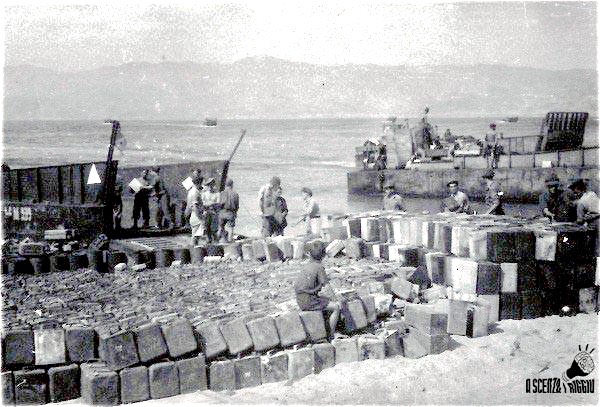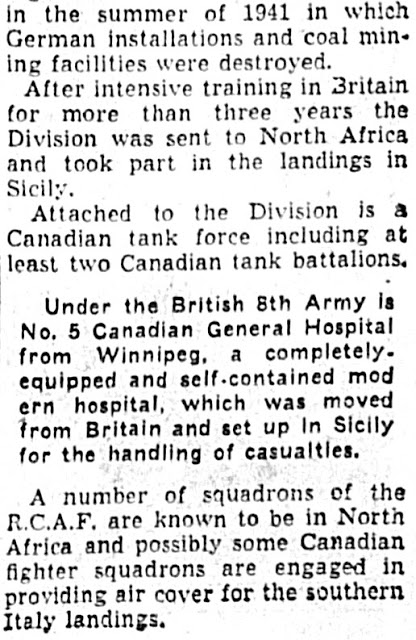The Invasion of the Toe of Italy's Boot, Beginning Sept. 3, 1943
Articles, Context from The Winnipeg Tribune, September 3, '43
Introduction:
Today's edition is a significant offering, so significant in fact - the Allies set foot on mainland Europe as an invasion force (to stay) for the first time since the evacuation of Dunkirk - that The Winnipeg Tribune put out a second printing later in the day, with more information about the success of the invasion and Canada's role in it. (As a result, I have split the offerings into two parts, 4a and 4b).
If we read particular stories we will become more familiar with our country's army's role, i.e., that of the Canadian 1st Division, under Canadian leadership, as part of the British 8th Army.
And if we read between the lines in other stories, we will become more familiar with our countries's navy's role, particularly of Canada's 80th Flotilla of Landing Crafts, where about 250 of the "1,000 Men..." (to which this site is so closely linked) were active for the first of about 30 labour-filled days.
I have made an effort to link a few of the newspaper stories with Canadian Navy memoirs, excerpts from rare Canadian Navy texts (i.e., from members of RCNVR and Combined Operations) and descriptive passages from a couple of my favourite books that detail the Mediterranean war front.
The above photo is likely from an earlier training exercise in England, with LCAs
(landing craft, assault). Canadians manned larger landing crafts in Italy (LCMs)
LCMs (landing craft, mechanised) deposit 100s of cans of fuel on Reggio's beaches
Several lengthy pieces provide countless details concerning a relatively easy landing, beginning in very early morning:
If a WW2 Canadian Navy veteran were alive today and read the next few lines, he might add or change a detail or two.
For example, my father might say that the trip from north of Messina (where he and a few mates lived in a bombed out house) to Reggio took longer than 20 minutes. "The trip was seven miles, there and back."
And about the line "Allied naval units escorted the landing barges," he'd remind us the sailors called them LCMs or landing craft. "Don't call 'em barges."
The front page news continues:
The following map reveals the distance from north of Messina to Reggio is exactly seven miles. Don't mess with my ol' man : )
I like Mr. Monson's brief, descriptive account but he just missed the memo re "barges." However, he does call 'em "landing craft" as well in the same breath:
More information is available online re Ronald Monson, Australian war correspondent (though nothing has been located yet re his time in Sicily or Italy). For example:
In May 1941 he was mentioned in dispatches for swimming across the Euphrates River under Iraqi fire to rescue a wounded British soldier. Slessor persuaded him in March 1943 that he was more valuable as a propagandist than a soldier. Monson next reported from Burma, and then from Alexandria, Egypt. (As found at Australian Dictionary of Biography)
More information about the author of the next piece (Alan Moorehead) can also be found at the
Australian Dictionary of Biography. Significant passages from
Eclipse, his exceptional book re his time in the Mediterranean Theatre of War, can be found on this site.
Please click here for more information.
Alan Moorehead, by Herald and Weekly Times, c.1962
As found at Australian Dictionary of Biography
I am not certain, of course, exactly where Mr. Moorehead was stationed in order to see the various scenes as aptly described above, i.e., "hundreds of ships and barges began setting out for the Italian coast", "vast numbers of men and vehicles have been feeding down to the invasions ports", "invasion barges - the same mosquito fleet that made the landing on Sicily - stole up the coast to take the army on board", etc., or where he stood to "hear many thousands of voices". But wherever he was, I do wish we could travel back in time to be there with him.
My father, a member of both RCNVR ("Hostilities Only," i.e., for the duration of the war) and Combined Operations ("on loan to the Royal Navy", "temporary") remembers the same night of invasion and adds some details from his point of the view as leading seaman or coxs'n aboard a Landing Craft, Mechanised, part of Canada's 80th Flotilla of LCMs. In his Navy memoirs he recalls the following:
At midnight on September 3, 1943 our Canadian landing craft flotilla, loaded once again with war machinery, left the beaches near Messina, Sicily and crossed the Messina Strait to Reggio Calabria in Italy. The invasion of Italy was underway.
It was no different touching down on the Italian beach at Reggio at around midnight, than on previous invasions. Naturally we felt our way slowly to our landing place. Everything was strangely quiet and we Canadian sailors were quite tense, expecting to be fired upon, but we touched down safely, discharged our cargo and left as orderly and quietly as possible.
In the morning light on our second trip to Italy across seven miles of the Messina Straits we saw how the Allied artillery barrage across the straits had levelled every conceivable thing; not a thing moved, the devastation was unbelievable and from day one we had no problems; it was easy come, easy go from Sicily to Italy.
Pages 113 - 114, "Dad, Well Done"
My father mentions that he transported "war machinery," but it is certain that other Canadian LCMs ferried Canadian troops for the first time, perhaps even the commander of the First Canadian Division:
In Alan Mooreheads' article, presented earlier, we read that Canadian troops had enjoyed "two weeks of rest and quiet" in Sicily, and that it had "given them great steadiness and confidence."
Alan Randal, one of many oft-published Canadian war correspondents, recalls the "rest-up in Sicily" before the push into Italy:
Troops had a break, faithful readers deserve one too:
More details re the Canadian troops follow:
A few details about "the Canadian Navy working with the Canadian Army", and more details about the role of Canadians in Combined Ops while in Italy, can be seen in the following account by another member of RCNVR and Combined Operations:
On September 1st, at one of the assembly points near Messina, from which the expedition was to cross, the Officers of the Flotilla were briefed. Thirty-six hours later they began to embark the Canadians of the Royal 22nd Regiment, the West Nova Scotians, and the Carleton and Yorks. Canadian soldiers and Canadian sailors were operating together at last.
In the early morning darkness of September 3rd the loaded craft moved up the Strait, close inshore on the Sicilian side, making for their take-off point. Among many ships crowding the narrow waters, "Warspite" and "Valiant" swept by, looming hugely. The wash from the battleships' passing bounced the landing craft like water bugs and sent huge waves over the sides to soak the men. The big ships of the Royal Navy, at that tense, nerve-fraying moment, came in for a heartfelt cursing.
At dawn the armies for the invasion of Italy moved across the six mile Strait. "Warspite" and "Valiant" were forgiven their trespass by the men in the landing craft as the Navy added to a great barrage put up by artillery firing from Sicily across the Strait. Screaming through the half-light overhead, thousands of shells from the artillery of the Army and the big Naval guns passed above the Flotilla.
Plumed explosions rose inland as the ramps of the craft went down and the conquerors of Sicily set foot on the Italian mainland. Great transit searchlights from the Sicilian side were cutting through the dim morning to assist navigation and directing smoke shells were providing some assistance mixed with a good deal of confusion.
For a month after the lightly-opposed Italian landing the 80th Flotilla carried out its familiar routine of ferry work.
Page 85, Combined Operations by C. Marks, London
Five former members of RCNVR and Combined Operations. Photo - C. Marks
Details re the role of Canadian troops in various situations:
Somebody must have heard, "The Allies are coming!"
The Allied forces are growing, indeed:
News of the Allied arrival was out and about:
More reports of Allied bombing runs prior to the invasion at the toe of the boot:
A survivor of the Dieppe Raid (August 19, a year earlier) declares the "invasion of Italy (is) a soft touch":
More will soon follow from the second edition of
The Winnipeg Tribune related to the September 3rd invasion of Italy.































No comments:
Post a Comment